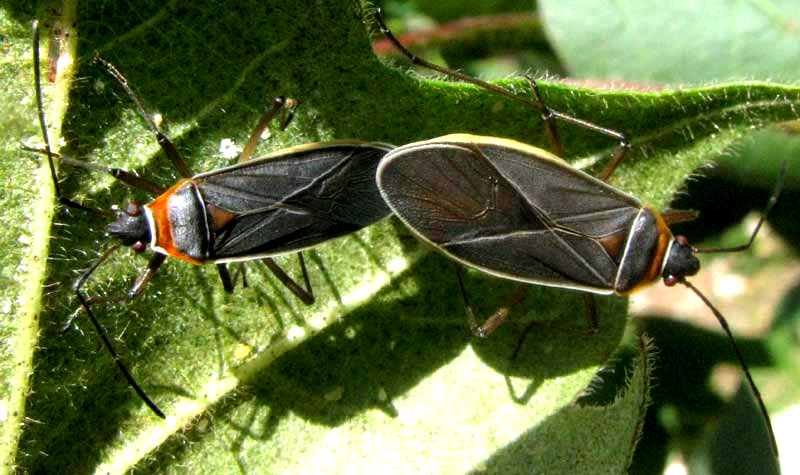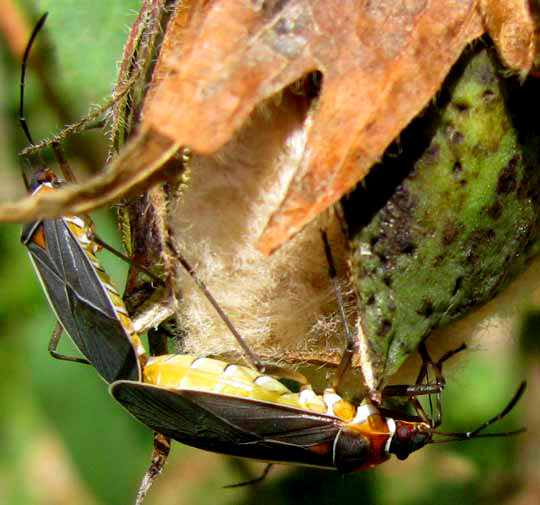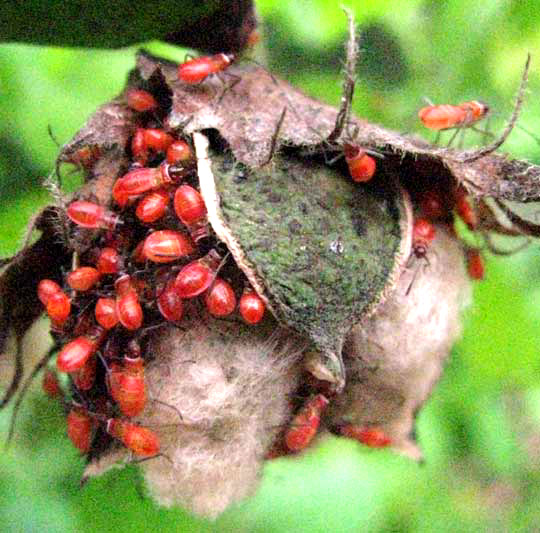Excerpts from Jim Conrad's
Naturalist Newsletter

from the January 29, 2012 Newsletter issued from Hacienda Chichen Resort beside Chichén Itzá Ruins; limestone bedrock; elevation ~39m (~128ft), N20.675°, W88.569°; central Yucatán state, MÉXICO
COTTON STAINERS
One morning this week while ducking beneath the Tree Cotton limb arching over the hut's path, I noticed a bug on a cotton leaf. Then another. And another and another, and then many, and most were joined together mating end-to-end. There were dozens of these bugs where just the day before I hadn't noticed a single one. Two copulating on a Tree Cotton leaf are shown above.
You can see that these are "true bugs," members of the Order Hemiptera, because the bases of their front pair of wings are thickened and leathery, while behind the thick parts the exposed wing surfaces are thin like black, veiny cellophane. Other "true bugs" include cicadas, hoppers and aphids. True bugs have "piercing" not "chewing" mouthparts. A female with her swollen abdomen, presumably displaying the afterworkings of extended sex, is shown poking her slender, straw-like proboscis into a dehiscing cotton bole below:

Snowbound volunteer identifier Bea in Ontario was glad to pounce on this summery challenge, but immediately recognizing the bug's order and knowing that it was part of an outbreak on my cotton, it didn't take much artful search-engine usage to come up with a verdict: Here we have DYSDERCUS MIMULUS, a member of the Family Pyrrhocoridae. Sometimes that family is referred to as the Red Bug Family, its red bugs being different from the US South's itch-causing Redbugs, also known as Chiggers.
Members of the genus Dysdercus are further sometimes called Cotton Stainers. In some parts of the world a member of that genus other than our D. mimulus, one much redder than ours, is famous for plaguing cotton, citrus and other plants. When that species punctures the developing bolls of cotton it introduces a fungus that "stains" the cotton fiber.
Thus, our Dysdercus mimulus can be called Cotton Stainer in a general sense, because it's a member of the Cotton Stainer genus Dysdercus, but, really, it just doesn't have an English name only for itself.
A day or two after our pictures were taken I was showing around some English visitors when we noticed Cotton Stainers on the flowering hibiscuses. Then it occurred to me: Of course Cotton Stainers would be attracted to hibiscuses, for cotton and hibiscus plants belong to the same Hibiscus Family, the Malvaceae.
There must be a chemical common to many or all Hibiscus Family members that wildly attracts and sexually arouses our little Cotton Stainers, which continue roaming over my Tree Cotton bushes, still mating, even on this Sunday morning.
from the February 19, 2012 Newsletter issued from Hacienda Chichen Resort beside Chichén Itzá Ruins; limestone bedrock; elevation ~39m (~128ft), N20.675°, W88.569°; central Yucatán state, MÉXICO
COTTON-STAINER NYMPHS GALORE
In late January we documented the many Cotton Stainer Bugs, often joined together mating, on my Tree Cotton plants. Now the fruits of their labor -- their abundant offspring -- are crawling all over my Tree Cottons, as shown below:

Those are tiny Cotton Stainer nymphs, a nymph in this case being the immature stage of an insect that does not undergo complete metamorphosis. Remember that in complete metamorphosis you get EGG --> LARVA --> PUPA --> ADULT. In simple metamorphosis it's EGG --> NYMPH --> ADULT. Nymphs are like small copies of the adult, except with undeveloped wings.
These nymphs don't like sunlight. During the day they tend to stay hidden, but at night they gather in conspicuous clusters as in the photo. If you puff hot breath on them in half a second they scatter. They're fast growing. In just three or four days I'd guess that they about doubled in size.